We’re getting used to driving in Cairo. I no longer stare with impotent attention through the windshield at oncoming traffic, or wince every time we pass another car or truck on the road. When Mr. Mohammad shows up each morning, we pile in with our water bottles and backpacks, lean back in the seats, and relax. We gave up on the seatbelts after the first day. There are seatbelts in the van, but somewhere along the line we realized that they wouldn’t save us if we were hit by a truck anyway.
Insh’allah, as Mr. Mohammad says.
Cairo
Alabaster Mosque
We’re staying in Cairo today. Our first stop today is the Citadel of Saladin, which houses the Alabaster Mosque and other buildings. Mark saw this mosque twenty years ago and was amazed at the new lighting. He remembers it being dim and very gloomy. His guide back then took a lighter to the alabaster walls to show how translucent they are. A flashlight does the same today with far less damage.
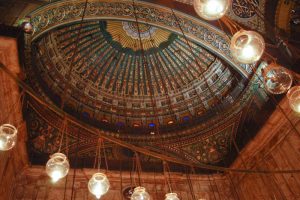
The mosque is stylistically Ottoman — the domes covered in silvered lead shine. Inside, the centuries old carpets on the alabaster floor are fitted exactly to the shape of the mosque. No one asked me to wear a scarf when we entered, but there were several women in the tour group behind us wearing long sleeved, shamrock-green robes issued to them by the custodian because they were inappropriately dressed. Everyone must take off their shoes.
Fatteh gave us a brief talk on the five pillars of Islam and let us loose to take pictures. He read the Koran while we wandered around with about two hundred other people. Despite the crowd, it was very quiet inside. It is a calm place, intimate and quiet, and more awe-inspiring than the stone churches in France, according to Mark. Mosques make you feel small in comparison to God, Cathedrals can just make you feel small, he said.
Citadel of Saladin

The rest of the Citadel is under massive reconstruction, but the views from the walls over Cairo are stunning, if a bit obscured by smog. Nearby is the green dome of the Al Nasir mosque, almost completely enclosed in scaffolding, and the fronts of many other buildings are draped in tarps. It’s early enough that the gardens aren’t blooming, but the open courtyard in the upper part of the Citadel is laid out like a large park. There are quite a few people here just walking about and enjoying the sun. It at least feels like we’re up above the smoggy city.
Al-Rifai and Amir Akhur Mosques

Down the hill from the Citadel are two mosques. The street between has been restored to the 15th century style, when the mosques were built. Inside the Rifai Mosque are the tombs of King Farouk and of the Shah of Iran (In a room with stunning green and red malachite marble floors. The inlaid stonework at first looks like painted decorations, and then you realize that the entire room is sheathed in stone. The ceilings are very high — and painted so beautifully we spent most of the visit craned over backwards to see them.
We decided to pass on the Khan el-Khalili bazaar (the largest souk in Cairo) when we hit the streets. We came out just after prayers and the streets were jammed with quite literally thousands people heading home and preparing for a festival, which occurs in a few days. We decide to come back later when the crowds thinned a bit. It just seems too overwhelming today.
Lunch at a downtown restaurant called Soiree, a tourist buffet lunch served along with the smell and sound of Eau de RAID being sprayed by the buffet line. The waiter responsible must have been chasing one big bug! Food was decent, though the restaurant was crowded with large tour groups.
Coptic Cairo
Coptic Cairo is much, much smaller than I thought — a tiny walled enclave with a few churches and the oldest synagogue in Cairo. The streets are narrow and cobbled and the buildings overhang them, just like the original Medieval city. A wall surrounds the entire old city, which is built on the site of the ancient Fort of Babylon, with the remains of enormous Roman drum towers.
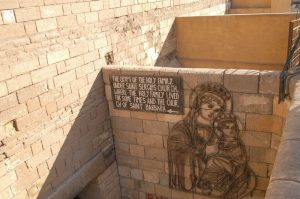
Copts are Christians — a bit different than Eastern Orthodox (they have their own Pope, for example) but closer to them than most of the Protestant sects. St Sergius is the oldest Coptic Church and it is supposed that the Holy Family were hidden here in the cellar. We couldn’t take any photos inside, but it looks like a very old Byzantine church, complete with icons and stylized paintings. Beni Ezra is a tiny synagogue nearby that is being restored again (or continually). There is a serious water problem in Cairo — the water table is continually rising — and they are fighting the damage in every single building in Old Cairo. The cellar of St. Sergius and the foundations of the Roman towers are filled with water that must be continuously pumped out.
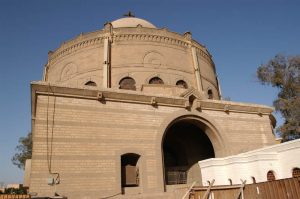
Two other churches here, St Barbara church and the church of St George are also crowded in the small old city. St Barbara is also called “the Hanging Church”, since it lies directly above the main gate. The church of St George is built into the foundations of the old Roman drum tower.
Fatteh pointed out an interesting bit of trivia to us while we sat in the ornately decorated hall of the synagogue. The Menorah and the word for God in Hebrew (Elohin), turned upside down, is the dome and crescent of the mosque and the word for Allah. I wonder which one of the pair — the Jew or the Muslim — were reading upside down?
City of the Dead
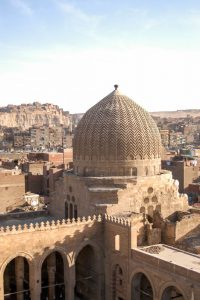
We decided to pass entirely on the Khan for today (we’ll be going there again tomorrow for dinner) and try to see the City of the Dead instead. This is a huge cemetery — and I mean HUGE. Kids were playing soccer when we arrived an we had a chance to see the Mausoleum and Mosque of Sultan Barquq, which is a combination school, mosque, and tomb. We arrived at prayer time and Mark was escorted to the tombs and up the crumbling minaret while I investigated the courtyard and the stonework in the inner rooms. The tombs are very beautiful, but the amazing thing is that people are living here. The cemetery is a thriving city here among the graves and tombs of the dead, with markets and even addresses of a sort. Egypt has a long history of reverence of the dead, so it is not surprising that the tombs and mausoleums here were adopted as houses, shared with them. Some 300,000 people live in the necropolis here and to the south.
It was 4:00 pm when we arrived, so we couldn’t go anywhere else — not a big deal, and maybe we can go back later and see more. It isn’t recommended that we go by ourselves, as the people living in the City of the Dead are very conservative and not necessarily willing to be tourist attractions. They are very private. We will try to return during the day, as some of the most interesting architecture in Cairo is in the Northern and Southern Cemeteries.
Egyptian Museum
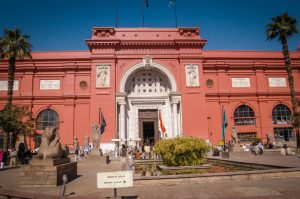
The museum, our next stop, is…WOW. Just wow. When Mark told me that they stacked things in the halls, I believed him because he is my husband but…they really do stack things in the halls! The cases are haphazardly strewn around the floors, stacked in piles, and the dust is so thick in some of them — undisturbed for decades, I’m sure — that you can’t read the occasional tag. Fatteh says that only about 10% of the collection is actually shown. They are building a new museum (The Grand Egyptian Museum) near the Mena House hotel, about 17000 sf (five times the size of the current museum) that will rotate displays in and out with a bit more speed than the current museum. It is supposed to open in ten years or so; the first foundation stone was laid in 2002.
Since we plan on coming back by ourselves in a few days, we did the quick “highlights” of the museum to get our bearings — seated statue of Chephren, the Scribe, Maidum Geese, Menkauhor, etc. We saw the Tutankhamen exhibit, Tanis treasures (from Shoshenq’s tomb) and the newly opened Mummy Hall. The super-crowded museum shop sells a comprehensive book on the displayed collection (in ten languages!) that is well worth the cost. Most of the labels are in Arabic (or French!), and most displays aren’t labelled at all that I can see.
Royal Mummy Hall
The mummy room is a small, quiet, humidity controlled room with all the royal mummies they have found. It is very tastefully done, very respectful. We couldn’t take any pictures, but it was interesting in a grisly, macabre sort of way. It’s a bit surprising to note that a lot of royal mummies have simply disappeared — probably during the last century when mummies were considered a souvenir of Egypt, they were dug up and probably unwrapped at ‘Mummy parties’ back in England. Or burnt as fuel or simply destroyed while tombs were looted. Before modern archeaology, the bodies in the tombs weren’t interesting enough or valuable enough to care about. They were simply annoyances to be dumped in an effort to find more gold.

Abandoning Fatteh to the comfortable courtyard outside, we walked along the upper hallway where stone statues and pieces of friezes are simply stacked on pallets. There are long galleries of glass cases containing sarcophagi and other items. Some are so dusty that it’s obvious that they have not been touched since the museum opened 100 years ago. It would be spooky to be stuck here overnight. Fatteh remarked later that the most scared he had ever been was when he was accidentally locked in the basement for a few minutes.